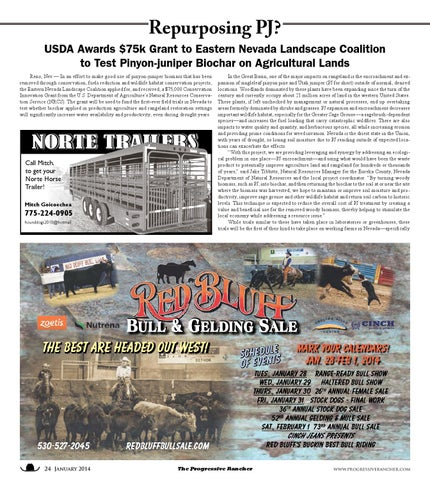Repurposing PJ?
USDA Awards $75k Grant to Eastern Nevada Landscape Coalition to Test Pinyon-juniper Biochar on Agricultural Lands Reno, Nev.— In an effort to make good use of pinyon-juniper biomass that has been removed through conservation, fuels reduction and wildlife habitat conservation projects, the Eastern Nevada Landscape Coalition applied for, and received, a $75,000 Conservation Innovation Grant from the U.S. Department of Agriculture’s Natural Resources Conservation Service (NRCS). The grant will be used to fund the first-ever field trials in Nevada to test whether biochar applied in production agriculture and rangeland restoration settings will significantly increase water availability and productivity, even during drought years.
NORTE TRAILERS Call Mitch, to get your Norte Horse Trailer! Mitch Goicoechea
775-224-0905 hounddogs2010@hotmail
the best are headed OUT West!
530-527-2045 24 January 2014
In the Great Basin, one of the major impacts on rangeland is the encroachment and expansion of singleleaf pinyon pine and Utah juniper (PJ for short) outside of normal, desired locations. Woodlands dominated by these plants have been expanding since the turn of the century and currently occupy about 21 million acres of land in the western United States. These plants, if left unchecked by management or natural processes, end up overtaking areas formerly dominated by shrubs and grasses. PJ expansion and encroachment decreases important wildlife habitat, especially for the Greater Sage Grouse—a sagebrush-dependent species—and increases the fuel loading that carry catastrophic wildfires. There are also impacts to water quality and quantity, and herbaceous species, all while increasing erosion and providing prime conditions for weed invasion. Nevada is the driest state in the Union, with years of drought, so losing soil moisture due to PJ residing outside of expected locations can exacerbate the effects. “With this project, we are providing leveraging and synergy by addressing an ecological problem in one place—PJ encroachment—and using what would have been the waste product to potentially improve agriculture land and rangeland for hundreds or thousands of years,” said Jake Tibbitts, Natural Resources Manager for the Eureka County, Nevada Department of Natural Resources and the local project coordinator. “By turning woody biomass, such as PJ, into biochar, and then returning the biochar to the soil at or near the site where the biomass was harvested, we hope to maintain or improve soil moisture and productivity, improve sage grouse and other wildlife habitat and return soil carbon to historic levels. This technique is expected to reduce the overall cost of PJ treatment by creating a value and beneficial use for the removed woody biomass, thereby helping to stimulate the local economy while addressing a resource issue.” While trials similar to these have taken place in laboratories or greenhouses, these trials will be the first of their kind to take place on working farms in Nevada—specifically
schedule of events
redbluffbullsale.com The Progressive Rancher
MARK YOUR CALENDARS! jan. 28-Feb 1, 2014
Tues., January 28 Range-Ready Bull Show Wed., January 29 Haltered Bull Show Thurs., January 30 26th Annual Female Sale Fri., January 31 Stock Dogs - Final Work 36th Annual Stock Dog Sale 52nd Annual Gelding & Mule Sale Sat., FEBRUARY 1 73rd Annual Bull Sale Cinch Jeans presents Red Bluff’s Buckin Best bull riding www.progressiverancher.com
